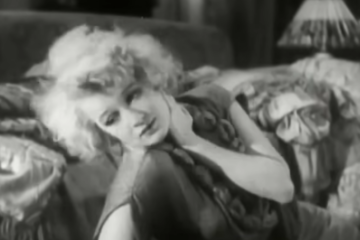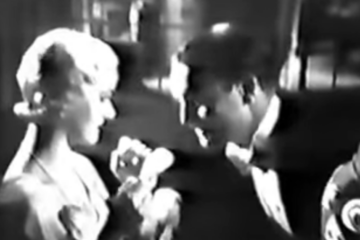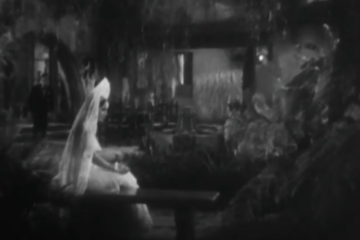
| Released by RKO | Directed By George Archainbaud |
Murder on the Blackboard: One Note
We’re going to do something a little differently this week. Instead of my usual review, instead, here’s the second full chapter from my new eBook, Murder on Celluloid: A Companion to the Hildegarde Withers Film Series. Enjoy!
The Victim
Louise Halloran, The Meek Teacher (Barbara Fritchie) – A beautiful young music teacher who has been looking nervous and toting a gun around during school hours. She’s afraid of someone, but who? When Hildegarde Withers discovers her body, it would seem that that gun wasn’t enough.
The Suspects
Jane Davis, The Bitter Roommate (Gertrude Michael) – Louise’s roommate and friend, but once it’s uncovered that Louise won $300,000 in a sweepstakes using Jane’s money, how likely is it that Jane offed Louise to claim her full share of the riches?
Mr. MacFarland, The Flirtatious Boss (Tully Marshall) – The principal of the school suffers from a cough and a wife who won’t leave him alone to enjoy his illicit affairs. He’s been chasing after Louise and Jane, hoping to snag a sweet little teacher. Did he murder Louise to keep her from ratting out his lecherous ways?
Otto Schweitzer, The Sinister Janitor (Frederick Vogeding) – The school’s janitor has a bushy mustache and a hidden stash of booze. He’s been selling extra bottles to Louise on the side. Did he kill her to keep a secret? I mean, he is pretty swarthy.
Addison “Ad” Stevens, The Ladies’ Man (Bruce Cabot) – The handsome assistant principal also doubles as the science teacher for the older boys of the school. Ad is the suave, cool teacher that everyone admires. He’s having a secretive romance with Jane, and it seems to chafe Louise. Is there a deeper reason for the conflict?
The Breakdown
“We caught him quicker than I thought.”
“Almost anything can be done quicker than you think of.”
A bit of a comedown after the playful brilliance of The Penguin Pool Murder, Murder on the Blackboard continues with many of the same threads but ends up weaving a different tapestry. While the movie is still solid with many excellent moments of comic relief, I have little doubt that if Blackboard had come first, it would have been the only entry in the series.
That may come from the more mundane setting, which is far too confined. Losing the eeriness of a gothic aquarium for a firetrap school house in the early 1930s, its major innovation is a cavernous, barely lit basement that houses the janitor, Otto Schweitzer. This is back in the good old days where the janitor lives in the school next to the coal bins and cavernous furnace with dirty pictures pasted on the wall and functioned a couple of sheets to the wind at all times.
It’s the end of a typical school day when the movie opens. We get most of the setup mentioned up in the suspects here, as people keep wandering into Jane Davis’ office and acting suspicious, hitting on her, or looking for that gun Louise just so happened to have misplaced.
Mrs. Withers bustles into this miasma of loathing and suspicion on her way to take a wayward boy named Leland off to stay after school for spreading rumors about Ms. Halloran. He is to write the word ‘gossip’ on the board 50 times, something that is easy to accomplish once he sticks his chalk into an eraser and writes the word twice at once.
Hildegarde lets him get away with it, though—she’s too busy being amused by a book that was sent to her by Piper, in appreciation for her help on the last case.
There are many references to The Penguin Pool Murder here, which has obviously put a feather in Withers’ cap. Which—much to many other’s chagrin—she knows all too well. For fans, surprisingly, the one thing that doesn’t get referenced in any way other than a rather obvious set of ellipses is the film’s last minute proposal. There does seem to be a minor hint at it, but we’ll cross that bridge when a person is pushed from it.
Speaking of corpses, Hildegarde wants Leland to apologize to Louise directly and hears her heeled shoes both arrive and depart quickly. Curious, Hildegarde investigates and finds Louise’s in the coatroom. Shocked at first, she notices one irregularity—one of Louise’s shoes is remarkably close to the door. Withers orders Leland to go get the police and begins to snoop before heading outside.
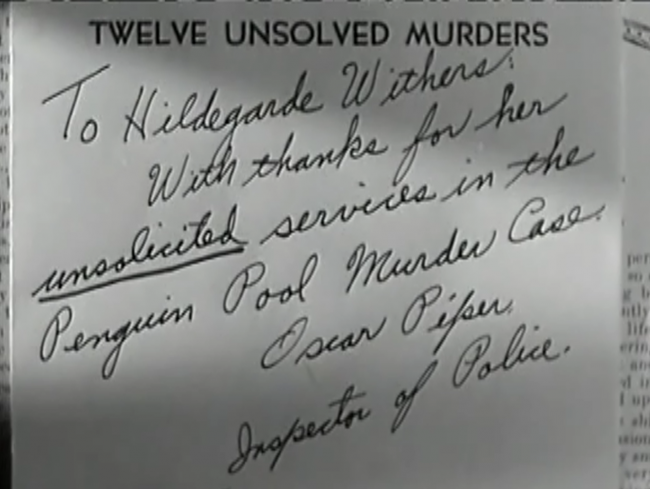
Oscar arrives, but when Withers returns to the room with Piper and a gaggle of detectives in tow, the body is gone. Oscar wisecracks before helping her search the school.
There is only one way in or out of the school—through the main door. The only other option is a slide in the very back that’s a fire exit, but an alarm would have sounded if it had been used. Since Withers has been watching the front of the building, that means Louise’s corpse is still in there somewhere.
One cute moment here—Hildegarde, worried that Piper is unprotected, carrying neither a gat nor a rod, offers him her umbrella to use. Piper tosses it to his associate Smiley, whom Withers immediately steals it back from.
After the three split off to search the place, a gunshot alerts them that alerts them that something’s happening in the basement. They find the unconscious body of Detective Donahue.
Edgar Kennedy appeared in both Penguin Pool and Blackboard and… a lot of movies, really. With over 400 credits (including 200 short subjects), he’d worked alongside Chaplin, Laurel and Hardy, the Marx Brothers, and practically every other comic or comic team under the sun. He was famous for his slow burn, suffering numerous insults while trying desperately to control his temper—and usually failing. He doesn’t get a chance to play the routine in this picture, but he’s given several great bits to be antagonized and Archainbaud makes the most of them.
Piper is incensed since Donahue’s condition is unstable. He orders Smiley, the other detective on the scene, to search the basement. The detective finds something rather disturbing—someone was digging a grave.
“People don’t dig graves just for the fun of it. Come on, Hildegarde.”
But, in one of the most badass lines Oliver gets in the series, she holds back as Piper and Smiley walk away.
“No thanks. I’m not interested in empty graves.”
Moments like this illustrate why Hildegarde makes such a compelling central figure.
Figuring she has a hunch, Hildegarde heads into Halloran’s office instead. Digging around Louise’s desk, she finds a bottle of whiskey and, rattled by the proceedings, does a shot of it. “That’s for my nerves,” she tells her reflection in the mirror, “Should anyone ask.”
She’s frightened again when a man bursts in—only for it to be Piper. He has a box of women’s shoes that was found in Schweitzer’s closet that are worn at the heel—meaning that Schweitzer either likes to wear lady’s shoes or has a fetish for used shoes and more than likely the feet that were in them. Either option is a rather risqué touch for the time.
The two go to investigate Addison’s room (… for some reason), where Hildegarde is surprised to discover a lighter and some lighter fluid on his desk. “Must be an expensive lighter—it won’t work!” Oscar sneers. Hildegarde also finds a dead ant in a jar just laying around, which pretty much puts it on par with several of my college dorm room living experiences. But here it’s a clue.
They’re interrupted by the fire alarm going off and can only see from the third floor the top of a man fleeing. The two bicker and get the alarm turned off, only for the ending of the noise allowing for Hildegarde to notice that the furnace has been turned on. Rushing to the basement, they throw open the door to find what’s left of Louise’s body being incinerated.
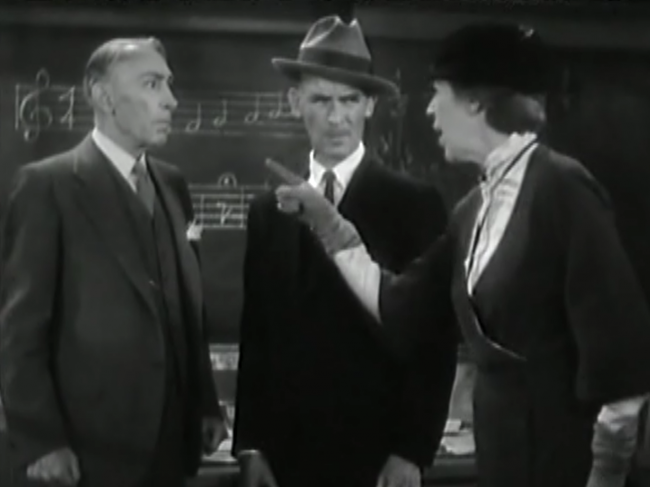
A little while later, as the detectives fish out what’s left of Louise, Smiley comforts a shaken Hildegarde. Smiley is played by Regis Toomey, a character actor who was born and raised in Pittsburgh. He was originally a lawyer before the stage beckoned, and his good looks made an affable choice for a leading man who wasn’t going to outshine successful female stars. He stuck it out in Hollywood for decades as a character actor, making turns in films like Meet John Doe (1941), The Big Sleep (1946), and Guys and Dolls (1955) before transitioning to television.
Back to the story. Hildegarde immediately suspects that the music exercise that Louise left on the blackboard may be a clue to who the killer was. Oscar arrives, annoyed that his men missed the body, but assuring Hildegarde that the basement was empty of people. Arriving out of the basement just at that moment is Schweitzer, drunk as a skunk. Piper puts him under arrest.
“How are you going to find him again in a cell if you couldn’t find him in a cellar?” snaps Withers.
Frederick Vogeding plays Schweitzer in a part that calls entirely for drunk acting and leering with a glint of menace. That’s unsurprising, since his body of work was mostly turns as ‘the villainous German’, something he’d get plenty of jobs doing as the 30s headed towards a close.
Withers thinks about the list of possible suspects and heads to Louise’s apartment, where she roomed with Janey. After she stiffs the cab driver with a pitiful tip (reminding him haughtily that he’s not a gigolo), she intersects with Addison and Janey who’ve just arrived home from dinner. She confronts them about Louise’s murder.
A brief look at the couple. Addison is played by Bruce Cabot, who had a career in Hollywood that lasted over 40 years, though most of it, outside of being the dashing hero in King Kong, was in supporting parts. He became friends with John Wayne and spent much of his later career in Western gear and living it up.
Gertrude Michael also had a lengthy career on the screen. Born in Alabama and working her way up from a stock company from Cleveland. She made it to Broadway in 1929. She got her start in movies in 1931, and had high profile bit parts like the snobby Alicia in I’m No Angel (1933). The most widely remembered role of Michael’s career came the same year as this one, as a singer in the nutso musical Murder at the Vanities (1934), wherein she sings a longing anthem called “Sweet Marijuana” while a pack of gauchos back her up and a bevy of half nude women made to appear as cactus flowers look on. Michael stuck it out, working in guest star roles on television before passing in 1964.
Meanwhile, Hildegarde continues to shake down Addison and Janey. Ad claims he was at the public library while Janey has no alibi. They announce to Withers that the two of them are to be wed, leading to this odd, wry comment from her.
“Those who try it once always try it again. Must be something in it.” It’s hard to shake the feeling that there’s something underneath what Hildegarde is saying there, possibly about herself. Or she’s simply getting ahead of the plot.
Things get more complicated when Hildegarde finds that Louise had won $300,000 in a lottery, and Janey claims that the money is actually hers. Janey counters that there are letters that will help prove that Louise had an admirer far more suspicious than herself. The letters are missing, though, and their argument is interrupted when the school’s principal calls Withers over to his house.
“The plot thickens!” Hildegarde exclaims.
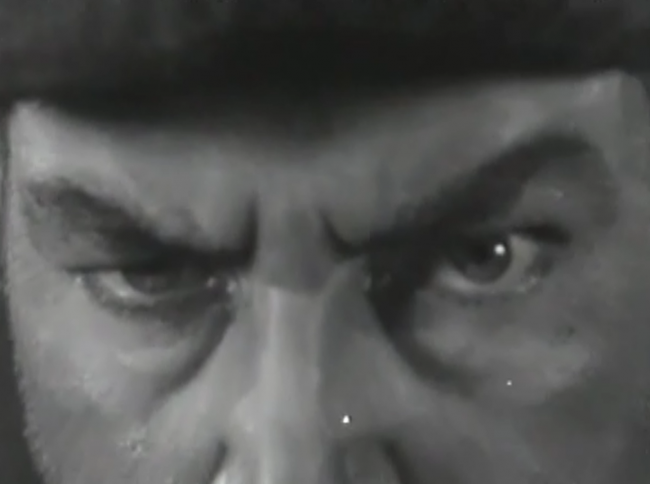
Tully Marshall is the lecherous principal, MacFarland. He’d been on the stage since 1873 in one capacity or another and made it on Broadway in 1887. (Supposedly, in 1902, he was the first actor to say the word ‘goddamn’ on Broadway.) He’d moved to silent film in 1914 and made an appearance in Intolerance (1916) and continued to find plenty of work in westerns, comedies, and everything in between.
MacFarland wants Hildegarde to investigate the murder of Louise, mostly by traveling to Chicago and talking to Louise’s parents. Suspicious, Hildegarde fakes a cough to get MacFarland to fetch her a drink while she explores his room, only to find a remainder of a love letter to Louise burning in the fireplace. This, as you may have guessed, is very suspicious.
Piper has the three suspects gathered the next day, save for Schweitzer who is still in jail. Each seems to be reeking with suspicion. The medical examiner arrives as well to explain that Louise was suffering from bone anemia and would have died shortly even if she hadn’t been murdered.
Since the police had found no bottles despite Schweitzer being blitzed the day before, Hildegarde is certain that there’s a hiding place in the basement worth uncovering. Withers, Piper and Smiley head down, but the lights go out and a thrown axe misses Hildegarde’s head by mere inches.
She’s determined to continue the search, though, and finds, with Oscar, a hidden passageway that leads to a warehouse next to the schoolhouse. The building is a storage place for alcohol (named, according to the boxes, “Duggan’s Dew of Kirkintilloch Highland Whisky”—a Scottish drink for sure).
Hildegarde sniffs the air. “It smells like my Uncle Henry used to smell when my mother wouldn’t let me kiss him at night.”
News reaches them that Schweitzer has escaped prison, leading Piper to assume that he’d been the one who had thrown the axe to silence Hildegarde, and the killer may be after Donahue next. Visiting him at the hospital gives Hildegarde an idea for finally finding their killer—have Donahue pretend to know who attacked him, and say that he will announce it the next day, giving the killer the night to sneak into the hospital to off him… and fall into her and Piper’s trap. Donahue isn’t a fan of the plan, but he is roundly ignored.
Having successfully baited the suspects, Oscar smiles broadly. “I ought to be a detective in the movies.”
“You could do all the acting,” sniffs Withers, “and the author could solve the crime!”
Oscar grumbles. “Someday I’m gonna write a good murder of my own…”
“Relax, Oscar. Relax.”
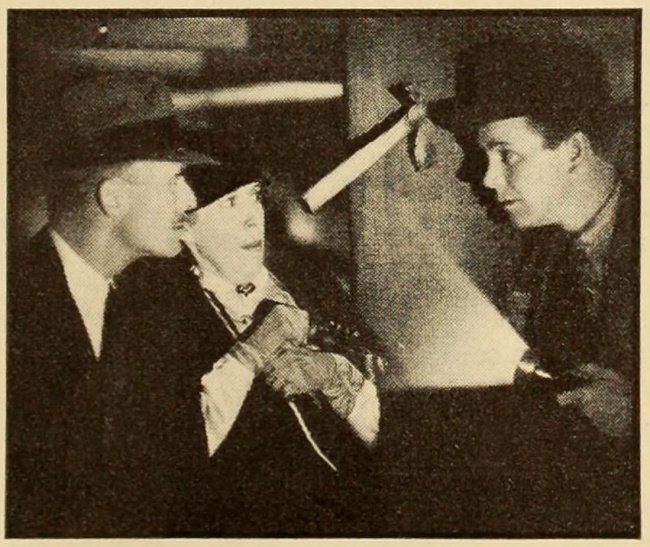
Spoilers follow about the end of the film.
The capture of the criminal goes relatively smoothly, if you can imagine that the murderer downing a cup of poison to off himself is a tidy way to end things. The killer was Addison, who’d secretly been married to Louise and found her unwilling to divorce him so that he could remarry Janey. His original plan, of poisoning the alcohol she was buying from Schweitzer with butane from lighter fluid, had been found out, so he had to do something more immediate to save his skin.
The titular ‘murder on the blackboard’ relates back to the film’s silliest clue. On the board, Louise’s last notations for class were a combination of ‘A’ and ‘D’ notes—spelling out ‘Ad’, Addison’s nickname. Since it doesn’t help solve the mystery and is only realized after the murderer is revealed, it’s kind of dopey.
The series’ message up to this point is not to trust anyone who starred in King Kong—which also makes one deeply regret Fay Wray didn’t take a turn as the murderess in the next film. Alas, it wasn’t to be.
More than that, though, Murder on the Blackboard delights in showing a thoroughly debauched world of education, taking a respectable institution and dowsing it in sin. Hildegarde is part of the old guard– the old, old guard—and still believes that educators should be good, honest and pure, some traits her colleagues lack. Even Janey, who Withers adores, has conspicuous vices.
In a nice little pre-Code touch (something which would evaporate in time for the next film), Janey can’t join them for their post-murder solving breakfast because she’s hosting Smiley at her place. Withers is shocked that she’d already had another man over so soon, and let him spend the night so soon after that. She mutters, “Well, I’ll be d—“
“Well, you wanted a happy ending,” grins Oscar.
“My idea of a happy ending is not marrying a policeman.”
“Ah, I get it. Proposals are out. But a fella could come up and see you sometime, couldn’t he?” Oscar laughs.
“Why, Oscar Piper! Why you dreadful man!”
The question of what happened on their way to the altar is never explicitly laid out, but it’s clear that they still harbor a deep affection for one another. Sublimated, perhaps, by their sense of professional decorum or even just their own prickly personalities, but it continues to resonate.
End spoilers.
Not seeking to mess too much with a good thing, George Archainbaud and Willis Goldbeck were both brought back, with Kenneth Macgowan producing for RKO once more.
Cinematographer Nicholas Musruaca started off as a chauffeur but his love of photography led him to his career. He was a staple at RKO, helping to establish the studio’s dark and moody look and working many of the studio’s biggest hits, from the movies of comedians Wheeler and Woolsey to this and the next four Hildegarde Withers films. Though his success varies across the four films, he’s always able to bring a good sense to the film’s worlds, giving the movies a great visual mixture of the needed morbid settings along with a lighter look when comedy is called for. He also had in his future films like Cat People (1942) and Clash by Night (1952).
Murder on the Blackboard was another hit for RKO (which could always use one), and another sequel was approved, only sooner this time and with a bigger budget. As the man next to Hildegarde smiles at the end of the film, “Better late than never, sister.”
Trivia & Tidbits
- Hollywood magazine has an interesting tidbit about Oliver from this time, noting that she imports all of her drinking water from Mountain Springs, Arkansas, and carried bottles of the water with her everywhere. Apparently she was ahead of her time.
- Hollywood Filmograph liked the humor but felt that the characters were “cheated out of a climax.”
- Earned a three dot ‘Good’ rating from Hollywood magazine, saying “the entire family will enjoy this laugh opus.” Not so sure the young’uns will enjoy the incinerated teacher, but, hey, depends on the kid, I guess.
- Earned a ‘B’ from Modern Screen. The Motion Picture Heralds said that the climax is “absolutely impossible to anticipate.” The Film Daily gave it a good rating, saying it was, “chock full of humor and novelty.” Picture Play called it “ingeniously plotted” and “is especially recommended to those who hold that a detective story need not be bizarre to be good.”
- On the other hand, Silver Screen rated it Fair, which isn’t too good especially compared to the other detective movie they rated just a few paragraphs below with an Excellent—The Thin Man.
- After completing the film, Edna May Oliver took a two month vacation abroad.
Important Link
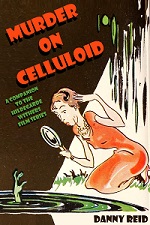 Now available as an eBook at Amazon is my newest book, Murder on Celluloid: A Companion to the Hildegarde Withers Film Series.
Now available as an eBook at Amazon is my newest book, Murder on Celluloid: A Companion to the Hildegarde Withers Film Series.
The book includes the above article and reviews of the other six films in the Withers film series, Murder on the Blackboard (1934), Murder on a Honeymoon (1935) (all starring Edna May Oliver). Murder on a Bridle Path (1936) (starring Helen Broderick), The Plot Thickens (1936), Forty Naughty Girls (1937) (both starring Zasu Pitts), and A Very Missing Person (1972) (starring Eve Arden). There’s also a look at the book series’ author, Stuart Palmer, a bonus review of the tangentially related Mrs. O’Malley and Mr. Malone (1951), and my own reflections on the series.
If you want to pick this up, it’s only $0.99 and you’d be doing me a solid.
Awards, Accolades & Availability
- This film is available as part of the Hildegarde Withers Mystery Collection on Amazon and Warner Archive. As someone who’s written a book on the movies contained in the set I highly recommend getting it! … And, of course, the book…
Comment below or join our email subscription list on the sidebar! |
|||
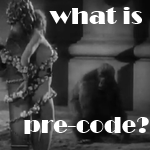 |
 |
 |
 |
